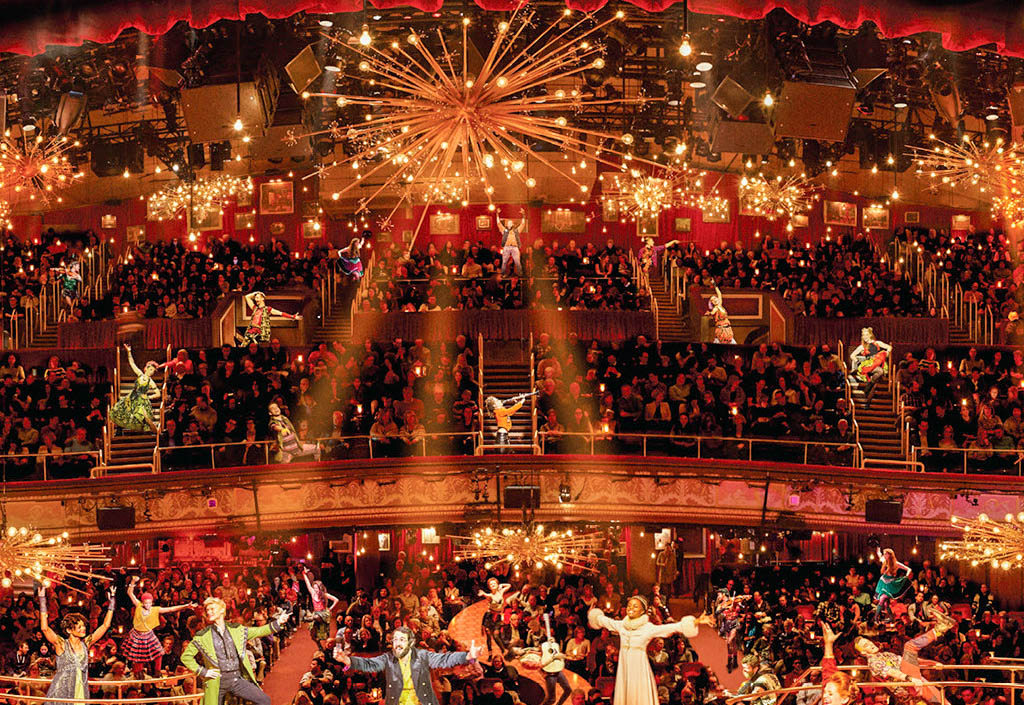
Before the show started, ensemble members ran out to different sections of the house, packaged pierogis in hand, ready to relay the rules of the space. They warned audiences that the show would be chaotic, assuring them it was acceptable to turn in different directions, but reminding them to mind the actors’ space. Subsequently, a loud storm siren sounded off, forcing everyone to take their positions for the Prologue. The grand doors opened at the top of the stage and Pierre appeared with his accordion, marking the beginning of the show.
Under the direction of Rachel Chavkin, “The Great Comet” boasts intimacy, wit, and marvelous enchantment. Audiences are encouraged to sing along with the ensemble members during musical numbers. They also provided viewers with shakers, props, and handwritten letters, which made for an elevated interactive theatrical experience.
The musical is an operatic adaptation of a few chapters from Leo Tolstoy’s “War and Peace,” with its book and lyrics written by three-time Tony nominee Dave Malloy. Malloy starred in the titular role of Pierre for a considerable amount of time during the show’s run.
But on Sunday, Sept. 3rd, 2017, “Natasha, Pierre, and the Great Comet of 1812” ended its ten-month run and said Goodbye to Its Gypsy Lovers. Ever since its appearance in 2012, critics and viewers have praised the musical for its originality and commitment to diversity. This past Tony Awards ceremony, the musical was awarded a total of 12 nominations (the most nominations of any production this year) and left the night with two trophies.
During the musical’s Broadway run at the Imperial Theatre, which has hosted the show since October, walking through the doors meant entering a world sequestered from New York City’s bustling streets. The gray walls of the lobby were plastered with posters of Pussy Riot, a nod to the show’s Moscow setting. Inside the theater, set and lighting designer Mimi Lien transformed the space to depict the city during the War of 1812, stylizing the space so that it harkened back to the expensive vodka dens of Russia.
Another aspect of “The Great Comet” that distinguished it from other shows was its layout. The show followed traditional seating with a mezzanine and an orchestra, in addition to stage seating, orchestra level cocktail tables, onstage tables, banquette stadium seating, and sunken tavern sets. The banquette seating allowed viewers to experience the show on stage without as much intervention from the actors, while the sunken taverns and onstage tables kept their occupants on their toes, and enabled swift transitions to the audience tables. Pieces of costumes wrapped around audience members or grazed their shoulders as the actors carried out each scene with unabashed confidence.
Regardless of where one sat, audience members were dispersed among folds of velvet red curtain decorated with portraits of Russian intellectuals and potential props. Golden starburst chandeliers hung from the rafters, illuminating the scene, and in the mezzanine and orchestra seating, tables with small candles interrupted clusters of seats, furthering the show’s intimate feeling. Lien’s Tony-winning set and lighting design transported viewers to a space where anything can happen in this unconventional 19th-century Russian world.
Each actor’s precision and gusto renders the performance as an operatic tour de force. Malloy’s musical range is nothing short of genius, and the music’s Slavic foundation slowly morphs into more traditional balladry, interspersed with contemporary electronica and rave music.
In terms of the book itself, Malloy took one of the most challenging Russian novels and made it an engaging comedic experience for every person involved. Every actor danced, acted, sang, and played instruments usually reserved for an orchestral pit. The music traveled and swelled throughout the house. The show’s choreography was at times athletic and at others, somehow poetic. The show isn’t for the faint of heart, and that’s what made it so explosive for Broadway.
Unfortunately, backlash from a poorly handled casting controversy, which, surprisingly, came from within the Broadway community, meant that Malloy’s masterpiece was forced to end its run early. For a show hailed for its advancement in diversity—which some argue was far greater than that of “Hamilton”—it closed its doors because of the accusation that it did not in fact respect diversity on the stage.
The closure of “Great Comet” is a testament to the problems with Broadway. For the most part, shows that last for years and years are not necessarily the best-received shows by critics or even the public, but those that remain funded by producers for one reason or the other. Shows have been forced to sacrifice certain creative decisions in order to keep running, allowing the logistics of the business to trump various essential decisions that should have been made freely.
It’s a shame that not everyone could experience the magic of Malloy’s outstanding show, but I’m sure that this will not be the last time in which a piece like “The Great Comet” will appear. It was not the first of its kind and it will surely not be its last. I wait eagerly for a show that will follow in its footsteps and hope that Broadway will not slide back in terms of diversity as it seems to be doing.
Kalee Kennedy can be reached at kkennedy@wesleyan.edu


Leave a Reply